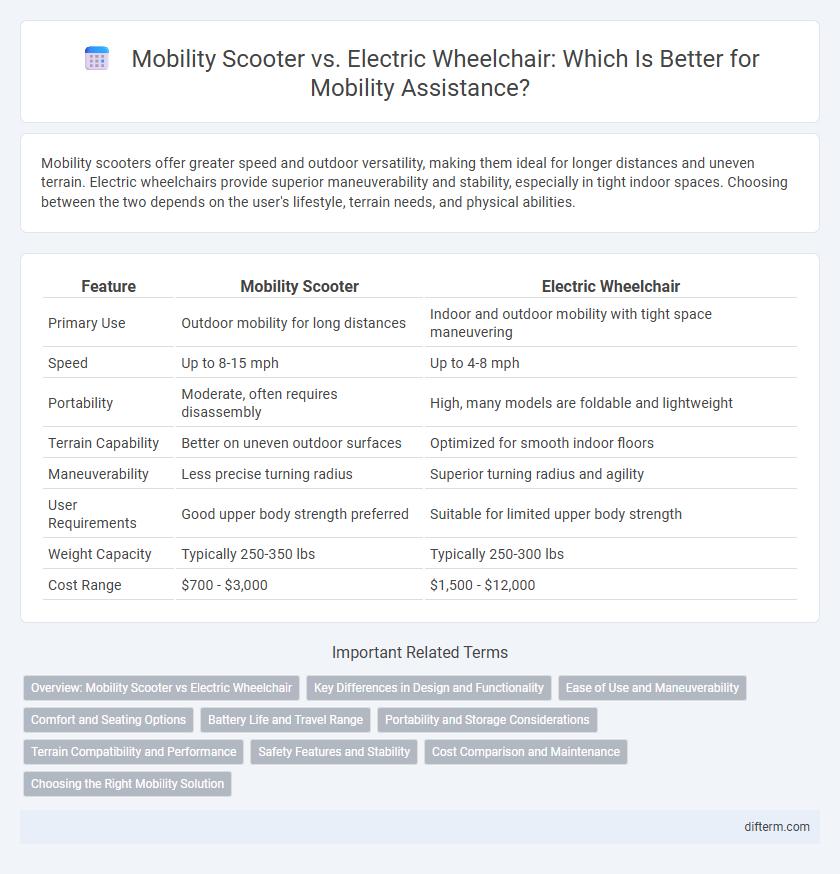Mobility scooters offer greater speed and outdoor versatility, making them ideal for longer distances and uneven terrain. Electric wheelchairs provide superior maneuverability and stability, especially in tight indoor spaces. Choosing between the two depends on the user's lifestyle, terrain needs, and physical abilities.
Table of Comparison
| Feature | Mobility Scooter | Electric Wheelchair |
|---|---|---|
| Primary Use | Outdoor mobility for long distances | Indoor and outdoor mobility with tight space maneuvering |
| Speed | Up to 8-15 mph | Up to 4-8 mph |
| Portability | Moderate, often requires disassembly | High, many models are foldable and lightweight |
| Terrain Capability | Better on uneven outdoor surfaces | Optimized for smooth indoor floors |
| Maneuverability | Less precise turning radius | Superior turning radius and agility |
| User Requirements | Good upper body strength preferred | Suitable for limited upper body strength |
| Weight Capacity | Typically 250-350 lbs | Typically 250-300 lbs |
| Cost Range | $700 - $3,000 | $1,500 - $12,000 |
Overview: Mobility Scooter vs Electric Wheelchair
Mobility scooters offer enhanced outdoor range and speed, ideal for users with good upper body strength and stamina, while electric wheelchairs provide superior maneuverability and stability for indoor use and users with limited upper body control. Electric wheelchairs often include customizable seating and advanced controls to support various disabilities, contrasting with the simpler, more affordable design of most mobility scooters. Choosing between them depends on the user's specific mobility needs, environments of use, and physical capabilities.
Key Differences in Design and Functionality
Mobility scooters feature a seated design with handlebars and are ideal for outdoor use, providing greater speed and longer range, while electric wheelchairs offer a compact, maneuverable structure better suited for indoor navigation and tight spaces. Scooters prioritize comfort and ease of use on uneven terrain, incorporating larger wheels and suspension systems, whereas electric wheelchairs emphasize precise control and accessibility features such as elevating seats. Battery life, turning radius, and user control mechanisms distinguish these devices, influencing suitability based on individual mobility needs and environment.
Ease of Use and Maneuverability
Mobility scooters offer superior ease of use with intuitive controls designed for outdoor travel on various terrains, making them ideal for users seeking independence without extensive training. Electric wheelchairs provide enhanced maneuverability in tight indoor spaces through precise joystick control and compact design, enabling effortless navigation in narrow hallways and crowded areas. Choosing between the two depends on the primary environment, with scooters excelling in outdoor mobility and wheelchairs optimizing indoor accessibility.
Comfort and Seating Options
Mobility scooters often feature padded, adjustable seats with armrests designed for extended outdoor use, prioritizing ride comfort and user posture. Electric wheelchairs typically offer advanced seating customization, including tilt, recline, and pressure relief options, enhancing comfort for users with specific medical needs. Both mobility aids provide ergonomic seating but differ in adjustability and support tailored to individual mobility demands.
Battery Life and Travel Range
Mobility scooters typically offer longer battery life and extended travel range, often reaching up to 25-30 miles on a single charge, whereas electric wheelchairs generally provide shorter ranges around 10-15 miles due to their compact design and power requirements. Battery capacity in mobility scooters ranges between 12Ah and 50Ah, supporting longer usage times suitable for outdoor mobility. Electric wheelchairs prioritize maneuverability and compactness, which can limit battery size and consequently reduce overall travel distance per charge.
Portability and Storage Considerations
Mobility scooters typically feature foldable or detachable parts, making them easier to transport and store in compact spaces such as car trunks or closets. Electric wheelchairs, while often bulkier, offer robust support but generally require more storage space and specialized vehicle modifications for transport. Choosing between the two hinges on balancing portability needs with the user's mobility support requirements and available storage options.
Terrain Compatibility and Performance
Mobility scooters typically excel on smooth surfaces like pavements and indoor flooring due to their larger wheels and stable chassis, but may struggle on uneven or rugged terrain. Electric wheelchairs often feature advanced suspension systems and more powerful motors, providing superior performance and maneuverability on rough or hilly landscapes. Choosing between the two depends on the primary terrain users navigate, with electric wheelchairs offering enhanced versatility for off-road conditions and mobility scooters favoring urban environments.
Safety Features and Stability
Mobility scooters offer enhanced stability through wider wheelbases and low centers of gravity, reducing the risk of tipping on uneven terrain, while electric wheelchairs typically feature advanced safety mechanisms such as anti-tip bars, automatic braking systems, and customizable speed controls for precise maneuverability. Both devices incorporate robust safety features like durable frame construction, seat belts, and LED lighting for visibility in low-light conditions, but electric wheelchairs often provide superior support for users with limited upper body strength due to their ergonomic design and adjustable seating. Selecting the appropriate mobility aid depends on individual stability needs and the specific environment, emphasizing the importance of built-in safety technology and reliability.
Cost Comparison and Maintenance
Mobility scooters generally have a lower upfront cost than electric wheelchairs, with prices ranging from $600 to $2,500 compared to $1,200 to $5,000 for electric wheelchairs. Maintenance expenses for mobility scooters tend to be less frequent and cheaper due to simpler mechanical parts and easier battery replacements. Electric wheelchairs often require specialized servicing and have higher maintenance costs because of advanced features like electronic controls and powered seating adjustments.
Choosing the Right Mobility Solution
Choosing the right mobility solution depends on individual needs, terrain, and lifestyle preferences. Mobility scooters offer greater speed and range, ideal for outdoor use and longer distances, while electric wheelchairs provide enhanced maneuverability and support for those with limited upper body strength. Evaluating factors such as user dexterity, battery life, weight capacity, and portability ensures optimal comfort and independence.
Mobility scooter vs electric wheelchair Infographic

 difterm.com
difterm.com